Abstract
We present a web geo-spatial framework for analyzing and continuously monitoring the spatio-temporal evolution of disease hot spots for detecting spatial areas with high concentrations of events in a geographic information system (GIS). To detect the hot spots, we adopt Extended Fuzzy C-Means algorithm. Each event is given by the geo-positional coordinates of the place of residence of the patient. The analyst can insert event data directly on the map or digitizing the address of the residence of the patient and using geo-coding services for locating the event. In our experiments, the data consist of geo-referenced patterns corresponding to the residence of patients in the district of Naples (Italy) submitted to a surgical intervention concerning the oto-laryngo-pharyngeal apparatus between the years 2008 and 2012. The results show the presence of two greatest hot spots: the first covers a geographical area that affects the city of Naples, the second covers parts of various towns around the famous vulcan Vesuvius, respectively.




















Similar content being viewed by others
References
Bezdek JC (1981) Pattern recognition with fuzzy objective function algorithms. Plenum Press, New York
Chainey SP, Reid S, Stuart N (2002) When is a hotspot a hotspot? A procedure for creating statistically robust hotspot geographic maps of crime. In: Higgs G (ed) Socio-economic applications of geographic information science. Routledge, New York, pp 21–36
De Runz C, Desjardin E, Piantoni F, Herbin M (2010) Anteriority index for managing fuzzy dates in archæological GIS. Soft Comput 14(4):339–344. doi:10.1007/s0050000904082
Di Martino F, Loia V, Sessa S (2007) Extended fuzzy C-means clustering algorithm for hotspot events in spatial analysis. Int J Hybrid Intell Syst 4:1–14
Di Martino F, Sessa S (2009) Implementation of the extended fuzzy C-means algorithm in geographic information systems. J Uncertain Syst 3(4):298–306
Di Martino F, Sessa S (2011) The extended fuzzy C-means algorithm for hotspots in spatio- temporal GIS. Expert Syst Appl 38:11829–11836. doi:10.1016/j.eswa.2011.03.071
Di Martino F, Mele R, Barillari UES, Barillari MR, Perfilieva I, Senatore S (2013) Spatio-temporal hotspots analysis for exploring the evolution of diseases: an application to oto-laryngo-pharyngeal diseases. Adv Fuzzy Syst ID 4252854: doi:10.1155/2013/385974
Di Martino F, Sessa S, Barillari UES, Barillari MR (2014) Spatio-temporal hotspots and application on a disease analysis case via GIS. Soft Comput 18(12):2377–2384. doi:10.1007/s0050001312117
Gath I, Geva AB (1989) Unsupervised optimal fuzzy clustering. IEEE Trans Pattern Anal Mach Intell 11:773–781. doi:10.1109/34.192473
Grubesic TH, Murray AT (2001) Detecting hotspots using cluster analysis and GIS, Annual Conference of CMRC, Dallas. http://www.ojp.usdoj.gov/cmrc
Harries K (1999) Geographic mapping crime: principle and practice. National Institute of Justice, Washington DC
Kaymak U, Babuska R, Setnes M, Verbruggen HB, van Nauta Lemke HM (1997) Methods for simplification of fuzzy models. In: Ruan D (Ed) Intelligent hybrid systems. Kluwer Academic Publishers, Dordrecht, pp 91–108. doi:10.1007/97814615619104
Kaymak U, Setnes M (2002) Fuzzy clustering with volume prototype and adaptive cluster merging. IEEE Trans Fuzzy Syst 10(6):705–712. doi:10.1109/TFUZZ.2002.805901
Krishnapuram R, Kim J (2002) Clustering algorithms based on volume criteria. IEEE Trans Fuzzy Syst 8(2):228–236. doi:10.1109/91.842156
Liu ZQ (2003) Fuzzy cognitive maps in GIS data analysis. Soft Comput 7:394–401. doi:10.1007/s0050000202280
Liu X, Zhang J, Cai W, Tong Z (2010) Information diffusion-based spatio-temporal risk analysis of grassland fire disaster in northern China. Knowl Based Syst 23:53–60. doi:10.1016/j.knosys.2009.07.002
McGuire PG, Williamson D (1999) Geographic mapping tools for management and accountability, Third International Crime Geographic Mapping Research Center Conference, Orlando
Murray AT, McGuffog I, Western JS, Mullins P (2001) Exploratory spatial data analysis techniques for examining urban crime. Br J Criminol 41(2001):309–329. doi:10.1093/bjc/41.2.309
Mullner RM, Chung K, Croke KG, Mensah EK (2004) Introduction: geographic information systems in public health and medicine. J Med Syst 28(3):215–221. doi:10.1023/B:JOMS.0000032972.29060.dd
Polat K (2012) Application of attribute weighting method based on clustering centers to discrimination of linearly non-separable medical datasets. J Med Syst 36(4):657–2673. doi:10.1007/s109160119741y
Wei CK, Su S, Yang MC (2012) Application of data mining on the develoment of a disease distribution map of screened community residents of Taipei County in Taiwan. J Med Syst 36(3):2021–2027. doi:10.1007/s1091601196647
Acknowledgments
The first and third author realized this work in the context of the project FARO financed from “Polo delle Scienze e delle Tecnologie” of the Università degli Studi di Napoli Federico II, Italy. We thank the referees for a careful reading of this paper, whose suggestions have greatly improved the presentation.
Author information
Authors and Affiliations
Corresponding author
Additional information
Communicated by V. Loia.
Rights and permissions
About this article
Cite this article
Di Martino, F., Mele, R., Sessa, S. et al. WebGIS based on spatio-temporal hot spots: an application to oto-laryngo-pharyngeal diseases. Soft Comput 20, 2135–2147 (2016). https://doi.org/10.1007/s00500-015-1626-4
Published:
Issue Date:
DOI: https://doi.org/10.1007/s00500-015-1626-4




